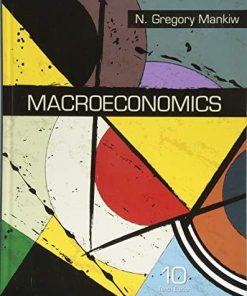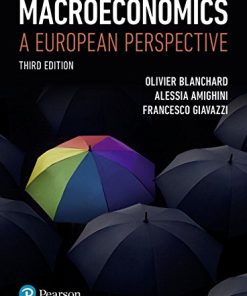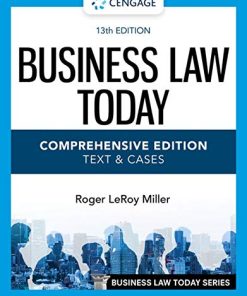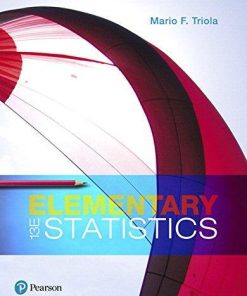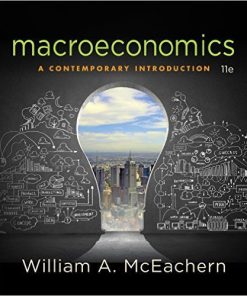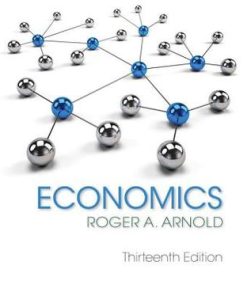(Ebook PDF) Macroeconomics 13th Edition by Roger A. Arnold 1337617393 978-1337617390 full chapters
$50.00 Original price was: $50.00.$25.00Current price is: $25.00.
Macroeconomics 13th Edition by Roger A. Arnold – Ebook PDF Instant Download/DeliveryISBN: 1337617393, 978-1337617390
Full dowload Macroeconomics 13th Edition after payment.

Product details:
ISBN-10 : 1337617393
ISBN-13 : 978-1337617390
Author: Roger A. Arnold
Ever wonder what gives money value, why the unemployment rate rises or falls, or why some economies grow faster than others? What causes the business cycle, or inflation, or high interest rates? MACROECONOMICS, 13E answers these intriguing questions and more as you open the world of economic analysis. You master macroeconomics as memorable examples from everyday macroeconomic events illustrate how economic forces link to everyday events. This edition offers videos ideal for self-study. “Video Office Hours” digital lectures walk you through worked problems, while brief “Working with Diagrams” videos demonstrate key concepts in graphing. Digital resources Aplia and MindTap with new Adaptive Test Prep enable you to assess your personal economic understanding. Explore the latest developments in today’s changing economy as you gain a thorough understanding of contemporary macroeconomics.
Macroeconomics 13th Table of contents:
Part 1. Economics: The Science of Scarcity
Chapter 1. What Economics Is About
1-1. Your Life, 2019–2029
1-2. A Definition of Economics
1-2a. Goods and Bads
1-2b. Resources
1-2c. Scarcity and a Definition of Economics
1-3. Key Concepts in Economics
1-3a. Opportunity Cost
1-3b. Opportunity Cost and Behavior
1-3c. Benefits and Costs
1-3d. Decisions Made at the Margin
1-3e. Efficiency
1-3f. Economics Is About Incentives
1-3g. Unintended Effects
1-3h. Exchange
1-4. Ceteris Paribus and Theory
1-4a. Ceteris Paribus Thinking
1-4b. What Is a Theory?
1-5. Economic Categories
1-5a. Positive Economics and Normative Economics
1-5b. Microeconomics and Macroeconomics
Chapter Summary
Key Terms and Concepts
Questions and Problems
Working with Numbers and Graphs
Appendix A. Working with Diagrams
A-1. Slope of a Line
A-2. Slope of a Line is Constant
A-3. Slope of a Curve
A-4. The 45-Degree Line
A-5. Pie Charts
A-6. Bar Graphs
A-7. Line Graphs
Appendix Summary
Key Terms and Concepts
Questions and Problems
Appendix B. Should You Major in Economics?
B-1. Five Myths About Economics and Being an Economics Major
B-2. What Awaits You as an Economics Major?
B-3. What Do Economists Do?
B-4. Places to Find More Information
B-5. Concluding Remarks
Chapter 2. Production Possibilities Frontier Framework
2-1. The Production Possibilities Frontier
2-1a. The Straight-Line PPF: Constant Opportunity Costs
2-1b. The Bowed-Outward (Concave-Downward) PPF: Increasing Opportunity Costs
2-1c. Law of Increasing Opportunity Costs
2-1d. Economic Concepts in a Production Possibilities Frontier Framework
2-2. Specialization and Trade Can Move Us Beyond Our PPF
2-2a. A Simple Two-Person PPF Model
2-2b. On or Beyond the PPF?
Chapter Summary
Key Terms and Concepts
Questions and Problems
Working with Numbers and Graps
Chapter 3. Supply and Demand: Theory
3-1. What Is Demand?
3-1a. The Law of Demand
3-1b. Four Ways to Represent the Law of Demand
3-1c. Why Does Quantity Demanded Go Down as Price Goes Up?
3-1d. Individual Demand Curve and Market Demand Curve
3-1e. A Change in Quantity Demanded Versus a Change in Demand
3-1f. What Factors Cause the Demand Curve to Shift?
3-1g. Movement Factors and Shift Factors
3-2. Supply
3-2a. The Law of Supply
3-2b. Why Most Supply Curves Are Upward Sloping
3-2c. Changes in Supply Mean Shifts in Supply Curves
3-2d. What Factors Cause the Supply Curve to Shift?
3-2e. A Change in Supply Versus a Change in Quantity Supplied
3-3. The Market: Putting Supply and Demand Together
3-3a. Supply and Demand at Work at an Auction
3-3b. The Language of Supply and Demand: A Few Important Terms
3-3c. Moving to Equilibrium: What Happens to Price When There Is a Surplus or a Shortage?
3-3d. Speed of Moving to Equilibrium
3-3e. Moving to Equilibrium: Maximum and Minimum Prices
3-3f. The Connection Between Equilibrium and Predictions
3-3g. Equilibrium in Terms of Consumers’ and Producers’ Surplus
3-3h. What Can Change Equilibrium Price and Quantity?
3-3i. It Is Important to Know Why the Price Changed: Back to Substitutes and Complements
3-3j. Epilogue: Who Feeds Cleveland?
Chapter Summary
Key Terms and Concepts
Questions and Problems
Working with Numbers and Graphs
Chapter 4. Prices: Free, Controlled, and Relative
4-1. Price
4-1a. Price as a Rationing Device
4-1b. Price as a Transmitter of Information
4-2. Price Controls
4-2a. Price Ceiling
4-2b. Price Floor: Definition and Effects
4-3. Two Prices: Absolute and Relative
4-3a. Absolute (Money) Price and Relative Price
4-3b. Taxes on Specific Goods and Relative Price Changes
Chapter Summary
Key Terms and Concepts
Questions and Problems
Working with Numbers and Graphs
Chapter 5. Supply, Demand, and Price: Applications
5-1. Application 1: U-Haul Rates and Demand
5-2. Application 2: Subsidizing the Consumption of Anything Can Raise Its Price
5-3. Application 3: 10 A.M. Classes in College
5-4. Application 4: Why Do Colleges Use GPAs, ACTs, and SATs for Purposes of Admission?
5-5. Application 5: Why Is Medical Care So Expensive?
5-6. Application 6: Do You Pay for Good Weather?
5-7. Application 7: The Price of an Aisle Seat
5-8. Application 8: College Superathletes
5-9. Application 9: Easier-to-Obtain Loans and Higher Housing Prices
5-10. Application 10: Speculators, Price Variability, and Patterns
5-11. Application 11: Supply and Demand on a Freeway
5-12. Application 12: Are Renters Better Off?
Chapter Summary
Questions and Problems
Working with Numbers and Graphs
Part 2. Macroeconomic Fundamentals
Chapter 6. Macroeconomic Measurements, Part I: Prices and Unemployment
6-1. Measuring the Price Level
6-1a. Using the CPI to Compute the Price Level
6-1b. Inflation and the CPI
6-1c. The Core PCE Index
6-1d. Converting Dollars from One Year to Another
6-2. Measuring Unemployment
6-2a. Who Are the Unemployed?
6-2b. The Unemployment Rate and the Employment Rate
6-2c. Common Misconceptions about the Unemployment and Employment Rates
6-2d. Reasons for Unemployment
6-2e. Discouraged Workers
6-2f. Types of Unemployment
6-2g. The Natural Unemployment Rate and Full Employment
6-2h. Cyclical Unemployment
Chapter Summary
Key Terms and Concepts
Questions and Problems
Working with Numbers and Graphs
Chapter 7. Macroeconomic Measurements, Part II: GDP and Real GDP
7-1. Gross Domestic Product
7-1a. Calculating GDP
7-1b. Final Goods and Intermediate Goods
7-1c. What GDP Omits
7-1d. GDP Is Not Adjusted for Bads Generated in the Production of Goods
7-1e. Per-Capita GDP
7-2. The Expenditure Approach to Computing GDP for a Real-World Economy
Consumption
7-2a. Using the Expenditure Approach to Compute GDP
7-2b. Common Misconceptions about Increases in GDP
7-3. The Income Approach to Computing GDP for a Real-World Economy
7-3a. Computing National Income
7-3b. From National Income to GDP: Making Some Adjustments
7-3c. Other National Income Accounting Measurements
7-3d. Net Domestic Product
7-3e. Personal Income
7-3f. Disposable Income
7-4. Real GDP
7-4a. Why We Need Real GDP
7-4b. Computing Real GDP
7-4c. The General Equation for Real GDP
7-4d. What Does It Mean if Real GDP Is Higher in One Year Than in Another?
7-4e. Real GDP, Economic Growth, and Business Cycles
Chapter Summary
Key Terms and Concepts
Questions and Problems
Working with Numbers and Graphs
Part 3. Macroeconomic Stability, Instability, and Fiscal Policy
Chapter 8. Aggregate Demand and Aggregate Supply
8-1. A Way to View the Economy
8-2. Aggregate Demand
8-2a. Why Does the Aggregate Demand Curve Slope Downward?
8-2b. An Important Word on the Three Effects
8-2c. A Change in Quantity Demanded of Real GDP Versus a Change in Aggregate Demand
8-2d. Changes in Aggregate Demand: Shifts in the AD Curve
8-2e. How Spending Components Affect Aggregate Demand
8-2f. Why Is There More Total Spending?
8-2g. Factors That Can Change C, I, G, and NX (EX – IM) and Therefore Can Change AD (Shift the AD Curve)
8-2h. Can a Change in the Money Supply Change Aggregate Demand?
8-2i. If Consumption Rises, Does Some Other Spending Component Have to Decline?
8-3. Short-Run Aggregate Supply
8-3a. Short-Run Aggregate Supply Curve: What It Is and Why It Is Upward Sloping
8-3b. What Puts the “Short Run” in the SRAS Curve?
8-3c. Changes in Short-Run Aggregate Supply: Shifts in the SRAS Curve
8-3d. Something More to Come: Peoples’ Expectations
8-4. Putting AD and SRAS Together: Short-Run Equilibrium
8-4a. How Short-Run Equilibrium in the Economy Is Achieved
8-4b. Thinking in Terms of Short-Run Equilibrium Changes in the Economy
8-4c. An Important Exhibit
8-5. Long-Run Aggregate Supply
8-5a. Going from the Short Run to the Long Run
8-5b. Short-Run Equilibrium, Long-Run Equilibrium, and Disequilibrium
Chapter Summary
Key Terms and Concepts
Questions and Problems
Working with Numbers and Graphs
Chapter 9. Classical Macroeconomics and the Self-Regulating Economy
9-1. The Classical View
9-1a. Classical Economists and Say’s Law
9-1b. Classical Economists and Interest Rate Flexibility
9-1c. Classical Economists on Prices and Wages: Both Are Flexible
9-2. Three States of the Economy
9-2a. Real GDP and Natural Real GDP: Three Possibilities
9-2b. The Labor Market and the Three States of the Economy
9-2c. Common Misconceptions About the Unemployment Rate and the Natural Unemployment Rate
9-3. The Self-Regulating Economy
9-3a. What Happens If a Self-Regulating Economy Is in a Recessionary Gap?
9-3b. What’s the Connection Between A Slow Recovery and How Quickly or Slowly Wages Adjust?
9-3c. What Happens If the Economy Is in an Inflationary Gap?
9-3d. The Self-Regulating Economy: A Recap
9-3e. Policy Implication of Believing That the Economy Is Self-Regulating
9-3f. Changes in a Self-Regulating Economy: Short Run and Long Run
9-3g. A Recap of Classical Macroeconomics and a Self-Regulating Economy
9-3h. Business-Cycle Macroeconomics and Economic-Growth Macroeconomics
Chapter Summary
Key Terms and Concepts
Questions and Problems
Working with Numbers and Graphs
Chapter 10. Keynesian Macroeconomics and Economic Instability: a Critique of the Self-Regulating Economy
10-1. Questioning the Classical Position and the Self-Regulating Economy
10-1a. Keynes’s Criticism of Say’s Law in a Money Economy
10-1b. Keynes on Wage Rates
10-1c. Different Markets, Different Rates of Adjustment
10-1d. Keynes on Prices
10-1e. Is It a Question of the Time It Takes for Wages and Prices to Adjust?
10-2. The Simple Keynesian Model
10-2a. Assumptions
10-2b. The Consumption Function
10-2c. Consumption and Saving
10-2d. The Multiplier
10-2e. The Multiplier and Reality
10-3. The Simple Keynesian Model in the AD–AS Framework
10-3a. Shifts in the Aggregate Demand Curve
10-3b. The Keynesian Aggregate Supply Curve
10-3c. The Economy in a Recessionary Gap
10-3d. Government’s Role in the Economy
10-3e. The Theme of the Simple Keynesian Model
10-4. The Simple Keynesian Model in the TE–TP Framework
10-4a. Deriving a Total Expenditures (TE) Curve
10-4b. Where the Consumption Curve and the Total Expenditures Curve Cut the Vertical Axis: More on Exhibit 12
10-4c. What Will Shift the TE Curve?
10-4d. Comparing Total Expenditures (TE) and Total Production (TP)
10-4e. Moving from Disequilibrium to Equilibrium
10-4f. The Economy in a Recessionary Gap and the Role of Government
10-4g. Equilibrium in the Economy
10-4h. The Theme of the Simple Keynesian Model
Chapter Summary
Key Terms and Concepts
Questions and Problems
Working with Numbers and Graphs
Chapter 11. Fiscal Policy and the Federal Budget
11-1. The Federal Budget
11-1a. Government Expenditures
11-1b. Government Tax Revenues
11-1c. Budget Projections
11-1d. Budget Deficit, Surplus, or Balance
11-1e. Structural and Cyclical Deficits
11-1f. The Public Debt
11-1g. Valued-Added Tax
11-1h. Tax Deductions Versus Subsidies
11-2. Fiscal Policy
11-2a. Some Relevant Fiscal Policy Terms
11-2b. Two Important Notes
11-3. Demand-Side Fiscal Policy
11-3a. Shifting the Aggregate Demand Curve
11-3b. Fiscal Policy: Keynesian Perspective (Economy Is Not Self-Regulating)
11-3c. Crowding Out: Questioning Expansionary Fiscal Policy
11-3d. Lags and Fiscal Policy
11-3e. Crowding Out, Lags, and the Effectiveness of Fiscal Policy
11-3f. Democracy in Deficit
11-4. Supply-Side Fiscal Policy
11-4a. Marginal Tax Rates and Aggregate Supply
11-4b. The Laffer Curve: Tax Rates and Tax Revenues
11-4c. Fiscal Policy and Expectations
Chapter Summary
Key Terms and Concepts
Questions and Problems
Working with Numbers and Graphs
Part 4. Money, the Economy, and Monetary Policy
Chapter 12. Money, Banking, and the Financial System
12-1. Money: What Is It and How Did It Come to Be?
12-1a. Money: A Definition
12-1b. Three Functions of Money
12-1c. From a Barter Economy to a Money Economy: The Origins of Money
12-1d. Money, Leisure, and Output
12-2. Defining the Money Supply
12-2a. M1
12-2b. Money Is More Than Currency
12-2c. M2
12-2d. Where Do Credit Cards Fit In?
12-3. How Banking Developed
12-3a. The Early Bankers
12-3b. The Bank’s Reserves and More
12-4. The Financial System
12-4a. Direct and Indirect Finance
12-4b. Adverse Selection Problems and Moral Hazard Problems
12-4c. The Bank’s Balance Sheet
12-4d. A Bank’s Business: Turning Liabilities into Assets
Chapter Summary
Key Terms and Concepts
Questions and Problems
Working with Numbers and Graphs
Chapter 13. The Federal Reserve System
13-1. The Structure and Functions of the Federal Reserve System (The Fed)
13-1a. The Structure of the Fed
13-1b. Functions of the Fed
13-1c. Common Misconceptions About the U.S. Treasury and the Fed
13-2. The Money Supply Expansion Process
13-2a. A Quick Review of Reserves, Required Reserves, and Excess Reserves
13-2b. The Money Supply Expansion Process
13-2c. The Money Supply Contraction Process
13-3. Other FED Tools and Recent FED Actions
13-3a. The Required Reserve Ratio
13-3b. The Discount Window and the Federal Funds Market
13-3c. The Fed and the Federal Funds Rate Target
13-3d. What Is Free Banking?
Chapter Summary
Key Terms and Concepts
Questions and Problems
Working with Numbers and Graphs
Appendix C. The Market For Reserves (or The Federal Funds Market)
C-1. The Demand for Reserves
C-2. The Supply of Reserves
C-3. Two Different Supply Curves For Reserves
C-4. The Corridor and Changing the Federal Funds Rate
Chapter 14. Money and the Economy
14-1. Money and the Price Level
14-1a. The Equation of Exchange
14-1b. From the Equation of Exchange to the Simple Quantity Theory of Money
14-1c. The Simple Quantity Theory of Money in an AD–AS Framework
14-1d. Dropping the Assumptions that V and Q Are Constant
14-2. Monetarism
14-2a. The Four Monetarist Positions
14-2b. Monetarism and AD–AS
14-2c. The Monetarist View of the Economy
14-3. Inflation
14-3a. One-Shot Inflation
14-3b. Continued Inflation
14-3c. Can You Get Rid of Inflation with Price Controls?
14-4. Money and Interest Rates
14-4a. Which Economic Variables Does a Change in the Money Supply Affect?
14-4b. The Money Supply, the Loanable Funds Market, and Interest Rates
14-4c. What Happens to the Interest Rate as the Money Supply Changes?
14-4d. The Nominal and Real Interest Rates
Chapter Summary
Key Terms and Concepts
Questions and Problems
Working with Numbers and Graphs
Chapter 15. Monetary Policy
15-1. Transmission Mechanisms
15-1a. The Money Market in the Keynesian Transmission Mechanism
15-1b. The Keynesian Transmission Mechanism: Indirect
15-1c. The Keynesian Mechanism May Get Blocked
15-1d. The Monetarist Transmission Mechanism: Direct
15-2. Monetary Policy and the Problem of Inflationary and Recessionary Gaps
15-2a. A Different View of the Economy: Patterns of Sustainable Specialization and Trade (PSST)
15-3. Monetary Policy and the Activist–Nonactivist Debate
15-3a. The Case for Activist (or Discretionary) Monetary Policy
15-3b. The Case for Nonactivist (or Rules-Based) Monetary Policy
15-4. Nonactivist Monetary Proposals
15-4a. The Constant-Money-Growth-Rate Rule
15-4b. The Predetermined-Money-Growth-Rate Rule
15-4c. The Fed and the Taylor Rule
15-4d. Inflation Targeting
15-4e. Nominal GDP Targeting
15-4f. A Gold Standard as Monetary Policy and the Value of the Dollar
Chapter Summary
Key Terms and Concepts
Questions and Problems
Working with Numbers and Graphs
Appendix D. Bond Prices and the Interest Rate
APPENDIX SUMMARY
Questions and Problems
Part 5. Expectations and Growth
Chapter 16. Expectations Theory and the Economy
16-1. Phillips Curve Analysis
16-1a. The Phillips Curve
16-1b. Samuelson and Solow: The Americanization of the Phillips Curve
16-2. The Controversy Begins: Are There Really Two Phillips Curves?
16-2a. Things Aren’t Always as We Think They Are
16-2b. Friedman and the Natural Rate Theory
16-2c. How Do People Form Their Expectations?
16-3. Rational Expectations and New Classical Theory
16-3a. Rational Expectations
16-3b. Do People Really Anticipate Policy?
16-3c. Price-Level Expectations and the SRAS Curve
16-3d. Expected and Actual Price Levels
16-3e. New Classical Economics and Four Different Cases
16-3f. Comparing Exhibit 9 and 10
16-4. New Keynesians and Rational Expectations
16-5. Looking at Things from the Supply Side: Real Business Cycle Theorists
Chapter Summary
Key Terms and Concepts
Questions and Problems
Working with Numbers and Graphs
Chapter 17. Economic Growth: Resources, Technology, Ideas, and Institutions
17-1. A Few Basics About Economic Growth
17-1a. Do Economic Growth Rates Matter?
17-2. A Production Function and Economic Growth
17-2a. The Graphical Representation of the Production Function
17-2b. From the Production Function to the LRAS Curve
17-2c. Emphasis on Labor
17-2d. Emphasis on Capital
17-2e. Emphasis on Other Resources: Natural Resources and Human Capital
17-2f. Emphasis on the Technology Coefficient and Ideas
17-2g. Discovery and Ideas
17-2h. Expanding Our Horizons
17-2i. Institutions Matter
Chapter Summary
Key Terms and Concepts
Questions and Problems
Working with Numbers and Graphs
Part 6. Government and the Economy
Chapter 18. Debates in Macroeconomics over the Role and Effects of Government
18-1. Macroeconomics and Government: The Debate
18-2. Tax Cuts, Tax Revenue, and Budget Deficits
18-3. The Economy: Self-Regulating or Not?
18-4. More Government Spending or A Cut in Taxes: Which Gives a Bigger Bang for the Buck?
18-5. More Government Spending or A Cut in Taxes: The Size and Scope of Government
18-6. The Degree of Crowding Out
18-7. The Politics of Government Spending
18-8. Monetary Policy: Rules Versus Discretion
18-9. Bailouts
18-10. Demand-Side and Supply-Side Views of the Economy and Government Tools for Changing Real GDP
Chapter Summary
Key Terms and Concepts
Questions and Problems
Working with Numbers and Graphs
Part 7. Market Failure, Public Choice, and Special-Interest-Group Politics
Chapter 19. Public Choice and Special-Interest Group Politics
19-1. Public Choice Theory
19-2. The Political Market
19-2a. Moving Toward the Middle: The Median Voter Model
19-2b. What Does the Theory Predict?
19-3. Voters and Rational Ignorance
19-3a. The Costs and Benefits of Voting
19-3b. Rational Ignorance
19-4. More about Voting
19-4a. Example 1: Voting for a Nonexcludable Public Good
19-4b. Example 2: Voting and Efficiency
19-5. Special-Interest Groups
19-5a. Information and Lobbying
19-5b. Congressional Districts as Special-Interest Groups
19-5c. Public-Interest Talk, Special-Interest Legislation
19-5d. Rent Seeking
19-5e. Bringing About Transfers
19-5f. Information, Rational Ignorance, and Seeking Transfers
19-6. Constitutional Economics
Chapter Summary
Key Terms and Concepts
Questions and Problems
Working with Numbers and Graphs
Part 8. Economic Theory-Building and Everyday Life
Chapter 20. Building Theories to Explain Everyday Life: From Observations to Questions to Theories to Predictions
20-1. A Different Kind of Chapter
20-2. The Process
20-3. Observation/Thought 1: The Birthrates in Various Countries Are Different
20-3a. The Question
20-3b. The Theory
20-3c. The Predictions
20-3d. A Detour: The Issue of Falsifiability (Refutability)
20-4. Observation/Thought 2: The Ethical Code of People Who Live in a Small Town Is Different from That of People Who Live in a Large City
20-4a. The Question
20-4b. The Theory
20-4c. The Predictions
20-5. Observation/Thought 3: The Closer the Dollar Tuition the Student Pays Is to the Equilibrium Tuition, the More on Time And Responsive University Instructors Will Be for Office Hours
20-5a. The Question
20-5b. The Theory
20-5c. The Predictions
20-6. Observation/Thought 4: Criminals Are Not Rational
20-6a. The Question
20-6b. The Theory
20-6c. The Predictions
20-6d. A Detour: Does Evidence Prove a Theory Correct?
20-6e. Another Detour: After You Have One Theory That Explains and Predicts, Search for Another
20-6f. A Final Detour: Why Prediction Is so Important, or Why Good-Sounding Stories Are Not Enough
20-7. Observation/Thought 5: More Students Wear Baseball Caps in Class on Exam Days Than on Other Days
20-7a. The Question
20-7b. The Theory
20-7c. The Predictions
20-8. Observation/Thought 6: Houses in “Good” School Districts Are Often More Expensive Than Comparable Houses in “Bad” School Districts
20-8a. The Question
20-8b. The Theory
20-8c. The Predictions
20-9. Observation/Thought 7: Are People Better Off with or without Health Care Vouchers?
20-9a. The Question
20-9b. The Theory
20-9c. The Predictions
20-10. Observation/Thought 8: People Who Give to Others Often Complain That They End Up Giving Too Much
20-10a. The Question
20-10b. The Theory
20-10c. The Predictions
Chapter Summary
Questions and Problems
Working with Numbers and Graphs
Part 9. International Economics and Globalization
Chapter 21. International Trade
21-1. International Trade Theory
21-1a. How Countries Know What to Trade
21-1b. A Common Misconception about How Much We Can Consume
21-1c. How Countries Know When They Have a Comparative Advantage
21-2. Trade Restrictions
21-2a. The Distributional Effects of International Trade
21-2b. Consumers’ and Producers’ Surpluses
21-2c. The Benefits and Costs of Trade Restrictions
21-2d. Why Nations Sometimes Restrict Trade
Chapter Summary
Key Terms and Concepts
Questions and Problems
Working with Numbers and Graphs
Chapter 22. International Finance
22-1. The Foreign Exchange Market
22-1a. The Demand for Goods
22-1b. The Demand for, and Supply of, Currencies
22-2. Flexible Exchange Rates
22-2a. The Equilibrium Exchange Rate
22-2b. Changes in the Equilibrium Exchange Rate
22-2c. Factors That Affect the Equilibrium Exchange Rate
22-3. Fixed Exchange Rates
22-3a. Fixed Exchange Rates and Overvalued or Undervalued Currency
22-3b. What Is So Bad about an Overvalued Dollar?
22-3c. Government Involvement in a Fixed Exchange Rate System
22-3d. Options Under a Fixed Exchange Rate System
22-4. Fixed Exchange Rates versus Flexible Exchange Rates
22-4a. Promoting International Trade
22-4b. Optimal Currency Areas
Chapter Summary
Key Terms and Concepts
Questions and Problems
Working with Numbers and Graphs
Part 10. Web Chapters
Chapter 23. The Economic Case for and Against Government: Five Topics Considered
23-1. Economics and Government
23-2. The Economic Case for Government
23-2a. Government Can Remove Individuals from a Prisoner’s Dilemma Setting
23-2b. Externalities
23-2c. Nonexcludable Public Goods
23-2d. The Case for Smaller or Larger Government
23-3. The Economic Case against Government
23-3a. Unintended Effects of Government Actions
23-3b. Government as Transfer Mechanism
23-3c. Economic Growth Versus Transfers
23-3d. Following the Leader in Pushing for Transfers
23-3e. Divisive Society: A NonExcludable Public Bad
Chapter Summary
Key Terms and Concepts
Questions and Problems
Working with Numbers and Graphs
Chapter 24. Stocks, Bonds, Futures, and Options
24-1. Financial Markets
24-2. Stocks
24-2a. Where Are Stocks Bought and Sold?
24-2b. The Dow Jones Industrial Average (DJIA)
24-2c. How the Stock Market Works
24-2d. Why Do People Buy Stock?
24-2e. How to Buy and Sell Stock
24-2f. Buying Stocks or Buying the Market
24-2g. How to Read the Stock Market Page
24-3. Bonds
24-3a. The Components of a Bond
24-3b. Bond Ratings
24-3c. Bond Prices and Yields (or Interest Rates)
24-3d. Common Misconceptions about the Coupon Rate and Yield (Interest Rate)
24-3e. Types of Bonds
24-3f. How to Read the Bond Market Page
24-3g. Risk and Return
24-4. Futures and Options
24-4a. Futures
24-4b. Options
People also search for Macroeconomics 13th:
microeconomics vs macroeconomics
macroeconomics definition economics
macroeconomics examples
macroeconomics is the study of
difference between microeconomics and macroeconomics
You may also like…
Uncategorized
Business & Economics
Commercial & Financial Law
Business Law Today, Comprehensive (MindTap Course List) 13th Edition
Business & Economics - Sales & Marketing
Uncategorized
Computers - Security
Hacking Multifactor Authentication 1st Edition Roger A. Grimes
Business & Economics




